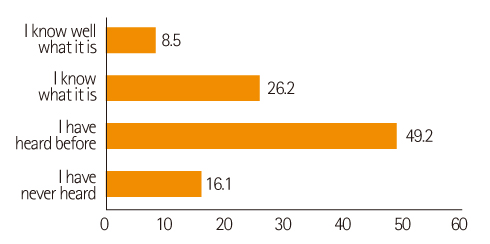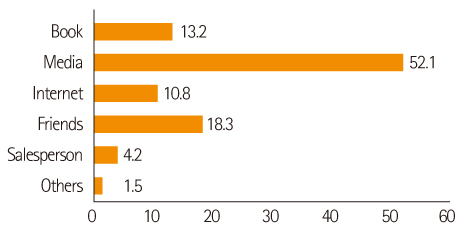Clin Nutr Res.
2012 Jul;1(1):37-48. 10.7762/cnr.2012.1.1.37.
A Study on Intake of Health Functional Food and Its Related Factors in Adults Living in Busan and Gyeongnam Area
- Affiliations
-
- 1Department of Food and Nutrition, Kyungnam University, Changwon 631-701, Korea. pej@kyungnam.ac.kr
- KMID: 2279751
- DOI: http://doi.org/10.7762/cnr.2012.1.1.37
Abstract
- The purpose of this study was to describe the pattern of "health functional food (HFF)" intake and related factors in Busan and Gyeongnam area and provide useful information for health promotion through the use of HFF. Among subjects of this study (n = 634), about 64% of the subjects reported that they are currently taking HFFs or other health foods or had HFFs in the last year. The reason of subjects taking HFF was to maintain and promote their health. They choose HFF by their own judgement or knowledge and the main place of purchasing HFF was the HFF store. Main food sources for promoting health in study subjects were nutrient fortified foods (76.8%), fruit or vegetable extracts (64.8%), HFF (64%), herbs or oriental medicines (29.6%), folk remedies or unidentified remedies (24.9%), respectively. The preference type of the products was capsule and liquid. 60.6% of consumers thought that HFF are expensive. 9.7% of consumers experienced the side effect such as stomachache and gastroenteric trouble. Using logistic regression analysis, the use of HFF was 1.9 times higher in female than male subjects indicating strong association between gender and HFF use. Additionally higher prevalence was found in female subjects for right conception of HFF and distinction of HFF. Interestingly subjects who consume less salts exhibited a higher tendency (-1.5 folds) in HFF intake than who prefer to use salt and seasonings in diets. In total study subjects 83.9% of them have known and heard about definition of the HFF. The major route of acquiring the information about HFF was mass media such as TV, internet and newspapers. Also subjects who had taken HFF exhibited high a proper conception toward the knowledge about 'distinction of HFF'. Taken together education programs considering gender, dietary habit and life style is necessary for consumers to select proper HFF.
MeSH Terms
Figure
Reference
-
1. Kim HK. Current status and prospect of nutraceuticals. J Food Sci Nutr. 2004. 9:1–14.2. Son DH. Strategy development of health functional food control system. Res Bull Kimchi Sci Technol. 2003. 9:94–105.3. Cha EK. A Study on the customer perception and satisfaction of health functional food [dissertation]. 2006. Anseoung: ChungAng University.4. The Korean Marketing News: Trend analysis of health functional food in Korea. 2010. cited 2011 November. Available from http://www.mknews.co.kr/view_index.php?IDX=16936.5. Korea Food & Drug Administration. Monitoring system of adverse reactions of functional health food (III). 2005. cited 2011 November 11. Available from http://rnd.kfda.go.kr.6. Rhim GS, Kim JS. A national framework for health functional food control system. Korean J Food Sci Technol. 2004. 37:41–49.7. Song HS. The study of the attitudes toward health food among middle-aged men in urban area [dissertation]. 1998. Seoul: Ewha Women's University.8. Lee SY. Factors associated with the consumption of health food among middle-aged women [dissertation]. 2001. Seoul: Yonsei University.9. Yoo SY. Food habits and intake patterns of health foods of adults in Ulsan Area [dissertation]. 2003. Ulsan: Ulsan University.10. Kim HJ, Kim MR. A study on health-functional foods intake pattern of consumers in Busan and Gyeongnam region. Korean J Hum Ecol. 2006. 15:341–352.11. Yoon JM. A study on health-functional foods intake pattern of consumers in Busan and Gyeongnam region [dissertation]. 2007. Busan: Silla University.12. Yoon S, Kwak HK, Kim YK, Kim HK, Park MS, Yeom KJ, Oh HS, Lee MJ, Lee JH, Ji GU. Functional Food. 2006. 1st ed. Seoul: Life Science Publishing Co..13. Shin JM. An analysis of intake of health foods and supplements and its associated factors in middle˙old aged adults living in Seoul and Gyeonggi region [dissertation]. 2002. Seoul: Yonsei University.14. Nam JS. A study on functional food intake and the related factors of office workers in Seoul and Gyeonggi area [dissertation]. 2004. Seoul: Yonsei University.15. Yoon SH. A Study on recognition and purchasing behavior of health functional food [dissertation]. 2007. Ulsan: Ulsan University.16. Choi MS. A study on adults' recognition and intakes of healthy functional foods in Jeonju [dissertation]. 2007. Jeonju: Chonbuk National University.17. Kim YS. A study on dietary patterns and composition of health foods in middle-aged adults living in Kangwon province [dissertation]. 2003. Seoul: Korea University.
Article18. Kang SJ. A study on dietary patterns and consumption of healthy functional foods in middle-aged adults living in Seoul and Gyeonggi area [dissertation]. 2003. Seoul: Korea University.19. Um JS. Intake status of health functional foods and influencing factors to ingestion for office workers [dissertation]. 2005. Seoul: Yonsei University.20. Russo JE, Staelin R, Nolan CA, Russell GJ, Metcalf BL. Nutrition information in the supermarket. J Consum Res. 1986. 13:48–70.
Article21. Muller TE. Structural information factors which stimulate the use of nutrition information: Field experiment. J Mark Res. 1985. 22:143–157.
Article22. Park JY. Aspects of dietary behavior and consumption pattern of health food by adults in Taejon [dissertation]. 2000. Daejeon: Daejeon University.
- Full Text Links
- Actions
-
Cited
- CITED
-
- Close
- Share
- Similar articles
-
- Fitness of Diet-Related Factors Explaining the Self-Rated Health (SRH) in Rural Older Adults with Discriminant Analysis
- Fast Food Intake Frequency and Health Practices
- Food literacy and its relationship with food intake: a comparison between adults and older adults using 2021 Seoul Food Survey data
- Factors affecting sugar intake in adults based on the social cognitive theory
- Food and Nutrient Consumption Patterns of Korean Adults Based on their Levels of Self Reported Stress



